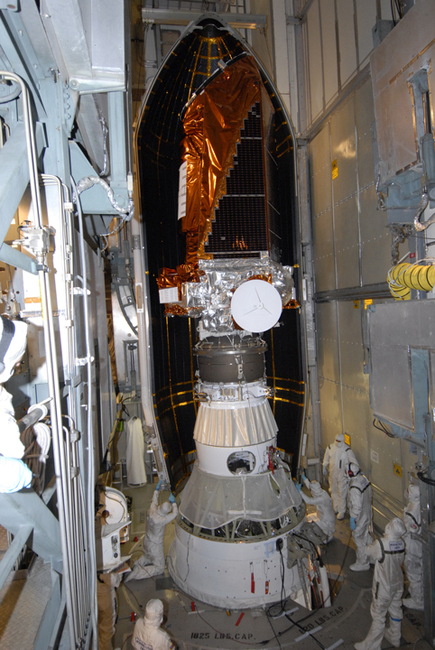Pressure On for NASA's Friday Launch of Planet-Hunting Kepler

This story was updated at 5:33 p.m. EST.
After last week's devastating loss of a $273.4 million satellite just after liftoff, the heat is on for NASA to successfully launch its new Kepler spacecraft late Friday and begin its hunt for Earth-like planets around alien stars.
Kepler, a $600 million telescope designed to spot Earth-sized planets in distant star systems, is poised to launch into to space Friday night at 10:49 p.m. EST (0349 March 6 GMT) from Cape Canaveral Air Force Station in Florida. The weather forecast looks pristine for the planned launch, with a 95 percent chance of favorable conditions, mission managers said.
The launch is NASA's first since the loss of the Orbiting Carbon Observatory (OCO), which crashed into the ocean on Feb. 24 about three minutes after liftoff when its protective nosecone shell failed to separate as planned.
"There's pressure to be successful on every mission," said Jon Morse, director of the astrophysics division at NASA headquarters in Washington, D.C., in a prelaunch briefing today. "We've learned our lessons from OCO, and the launch services program has done an amazing job in the last week pulling together an analysis of any commonality with the previous launch."
NASA delayed Kepler's liftoff by one day to perform extra checks on its Delta 2 rocket to make sure it was ready for launch. After a thorough analysis, engineers gave Kepler's Delta 2 rocket a clean bill of health, finding no issues similar to that which doomed the Taurus XL booster that launched the OCO satellite, Morse added.
"They've done an amazing job," Morse said. "They thoroughly screened Kepler's situation at the review."
Breaking space news, the latest updates on rocket launches, skywatching events and more!
NASA is under scrutiny this week following a Government Accountability Office report citing that the agency is almost $1.1 billion over budget on nine different space projects, a list that includes Kepler and the agency's next flagship mission to Mars — the Mars Science Laboratory, according to the Associated Press.
Hunting Alien Earths
The Kepler space telescope is dedicated to searching for Earth-like planets circling other stars in orbits that would be conducive to supporting life. The telescope cannot find proof of life itself, but it could identify candidate planets with the potential for habitability.
"This is a historical mission, it's not just a science mission," said Ed Weiler, NASA's associate administrator for science missions. "It really attacks the very basic human question that's part of our genetic code — 'Are we alone?'"
To date, astronomers have discovered nearly 340 extrasolar planets, but most of those have been gas giants the size of Jupiter or Saturn that orbit extremely close to their parent stars, researchers said.
"Kepler is NASA's first mission capable of detecting Earth-like planets in the habitable zone of stars like the sun," said Patricia Boyd, NASA's Kepler program scientist.
Also known as the Goldilocks zone, the habitable zone around a star is a region in which a planet can orbit and still sport liquid water at the surface.
"The habitable zone is the area where things are just right," said William Borucki, Kepler's principal scientist at NASA's Ames Research Center in California. "The planets are not too hot, they're not too cold, they're just right."
To find those planets, Kepler will stare at a patch of sky near the constellations of Cygnus and Lyra for about 3 1/2 years and search for slight dimming in some 100,000 target stars — the telltale sign of an extrasolar planet.
"We're looking for transits," Borucki said. "We're looking for a planet to cross its star."
After launch, Kepler will trail behind the Earth, orbiting the sun once every 371 days while keeping its gaze fixed at its target star field. The target covers an area about the size a human hand would cover if held against the sky at arm's length, Kepler researchers said.
Kepler has two opportunities to launch Friday night, first during a three-minute window that opens at 10:49 p.m. EST, and again at 11:13 p.m. EST (0413 March 7 GMT).
"We're ready to fly tomorrow," said Omar Baez, NASA's launch director. "Hopefully, we'll hit it right on the money at 10:49:57 p.m."
NASA will broadcast the Kepler's launch late Friday night live on NASA TV beginning at 8:30 p.m. EST (0130 March 7 GMT). Click here for SPACE.com's live launch webcast and countdown coverage.
Join our Space Forums to keep talking space on the latest missions, night sky and more! And if you have a news tip, correction or comment, let us know at: community@space.com.

Tariq is the award-winning Editor-in-Chief of Space.com and joined the team in 2001. He covers human spaceflight, as well as skywatching and entertainment. He became Space.com's Editor-in-Chief in 2019. Before joining Space.com, Tariq was a staff reporter for The Los Angeles Times covering education and city beats in La Habra, Fullerton and Huntington Beach. He's a recipient of the 2022 Harry Kolcum Award for excellence in space reporting and the 2025 Space Pioneer Award from the National Space Society. He is an Eagle Scout and Space Camp alum with journalism degrees from the USC and NYU. You can find Tariq at Space.com and as the co-host to the This Week In Space podcast on the TWiT network. To see his latest project, you can follow Tariq on Twitter @tariqjmalik.
